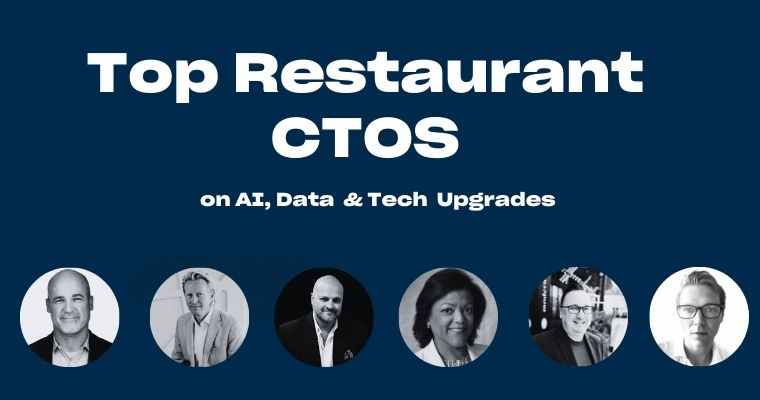Top Restaurant CTO’s featured in the podcast series include:
- Dawn Gillis, CTO, Freebird’s World Burrito
- Justin Keenen, former Head of Technology, Hart House
- Michael Chachula, CIO, Fat Brands
- Darien Bates, former CTO at &Pizza & Founder, Fourtop
- Josh Boshard, COO, The Savory Fund
- Phil Crawford, CTO, CKE Restaurants
Here’s what they had to say…
Take big risks & cultivate buy-in
As Freebirds World Burrito chief technology officer (CTO) Dawn Gillis told us, fear of the unknown often keeps restaurant operators from making critical steps towards tech advancement. CTOs have to get key stakeholders on board before they’ll commit to much-needed overhauls of legacy tech.
Gillis cultivated stakeholder buy-in by sharing her vision (and how it aligns with the brand vision), listening to their fears and concerns, and explaining the benefits of the new systems and “MACH” architecture. (MACH = Microservices-based, API-first, Cloud-native, and Headless.
Similarly, CKE Restaurants CTO Phil Crawford shared that CKE operates on a policy of transparency and strong communications that has paid dividends in its relationship with franchisees. When CKE wants to test a new solution, it does so in company stores first. Then it shares the results with franchisees, letting them know what worked—and what didn’t. Crawford calls this process “the winning formula.”
Update your tech stack: CTO recommendations
📝Put the employee experience first: Darien Bates of Fourtop Solutions and Keenen both talked about an employee-first vision. Bates, who was formerly the CTO at &pizza, recommends focusing your tech overhaul on the employee experience first, and then building out from there. An employee-first philosophy will naturally encompass benefits for all stakeholders as the system takes shape.
📝Crawford mused on the imbalance between leadership and store operators. In the traditional balance of power, leadership has all the decision-making power but none of the information. Individual stores have the experience but none of the authority. Bridging that gap is critical to make good tech choices.
📝Centralize & activate your data: Your data contains enormous potential to help your brand grow and prosper, but you have to put it to work. Bates compares rogue data to an ocean of water. Your systems are the glasses and bowls and aquariums that ultimately contain the data and help you view and understand it. Boshard agrees that you need to do this if you want to be able to detect trends and track your guests’ behavior and preferences. Data ownership is paramount, he said. Use your tech to mine your data, and partner with experts who can help you do that (or alternatively, just hire them).
Build a future-ready, API-friendly platform
Case in point: At 30 of CKE’s restaurants, AI takes orders from drive-through guests via natural language processing (NLP) technology. The models are bilingual, and get the orders right more than 90% of the time. As a result, employees can focus on making the order and providing outstanding service at the window. CKE also uses AI machine learning on the backend through Snowflake and reporting solutions.
Upgrading your systems isn’t a “once and done” job, though. Restaurants must continually innovate or risk falling behind those that do. And for the near-term, the future is all about artificial intelligence (AI). ChatGPT has made headlines for its potential to completely upend traditional ways of thinking about content—and school work. But generative AI has the potential to create more than just an ethically dubious history paper. Boshard said that businesses that aren’t using AI to help build, code, and structure their businesses may be missing the boat.
“We all know quantum computing is prevalent and can do and process a lot more information and come to amazing results if you train these models correctly,” Crawford says.
Bates adds that one real value of generative AI for restaurateurs is going to be in the intelligence’s ability to use data to create forecasts in a fraction of the time that a human would need to do the same thing. But with that great power will also come great responsibility. Brands will need to use AI in a way that creates not only a great customer experience, but also a great employee experience. Otherwise, workers may find themselves with a nightmare boss straight out of an old episode of The Jetsons.
📝Find the right fit for your brand: At the same time, though, best in class isn’t going to be the same for everyone. As FAT Brands chief information officer Michael Chachula told us, “You need to have the right fit for your brand. That’s what best of breed is.”

